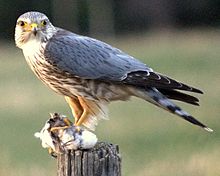Merlin (bird)
| Merlin | |
|---|---|
 |
|
| Male prairie merlin (F. c. richardsoni) with prey in Alberta (Canada) | |
| Scientific classification | |
| Kingdom: | Animalia |
| Phylum: | Chordata |
| Class: | Aves |
| Order: | Falconiformes |
| Family: | Falconidae |
| Genus: | Falco |
| Species: | F. columbarius |
| Binomial name | |
|
Falco columbarius Linnaeus, 1758 |
|
| Diversity | |
| 3–9 subspecies (see text) | |
 |
|
| Range of F. columbarius Summer only range Year-round range Winter only range | |
| Synonyms | |
|
Aesalon columbarius (Linnaeus, 1758) |
|
Aesalon columbarius (Linnaeus, 1758)
Falco aesalon Tunstall, 1771 (but see text)
The Merlin (Falco columbarius) is a small species of falcon from the Northern Hemisphere, with numerous subspecies throughout North America and Eurasia. A bird of prey once known colloquially as a pigeon hawk in North America, the Merlin breeds in the northern Holarctic; some migrate to subtropical and northern tropical regions in winter. Males typically have wingspans of 53–58 centimetres (21–23 in), with females being slightly larger. They are swift fliers and skilled hunters who specialize in preying on small birds in the size range of sparrows to quail. The Merlin has for centuries been well regarded as a falconry bird. In recent decades merlin populations in North America have been significantly increasing, with some merlins becoming so well adapted to city life that they forgo migration.
The name "merlin" is derived from Old French esmerillon via Anglo-Norman merilun or meriliun. There are related Germanic words derived through older forms such as Middle Dutch smeerle, Old High German smerle and Old Icelandic smyrill.Wycliffe's Bible, around 1382, mentions An Egle, & agriffyn, & a merlyon. The species was once known as 'pigeon hawk' in North America.
The genus name is Late Latin; falco derives from falx, falcis, a sickle, referring to the claws of the bird. The species name columbarius is Latin for "of doves" from "columba", "dove".
...
Wikipedia

